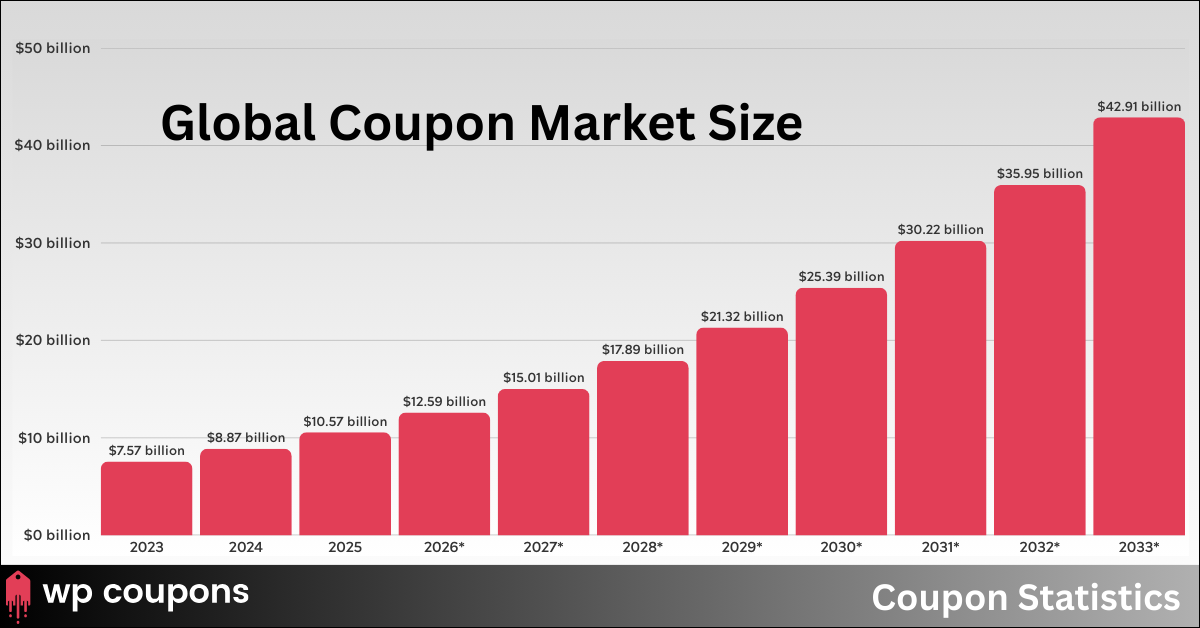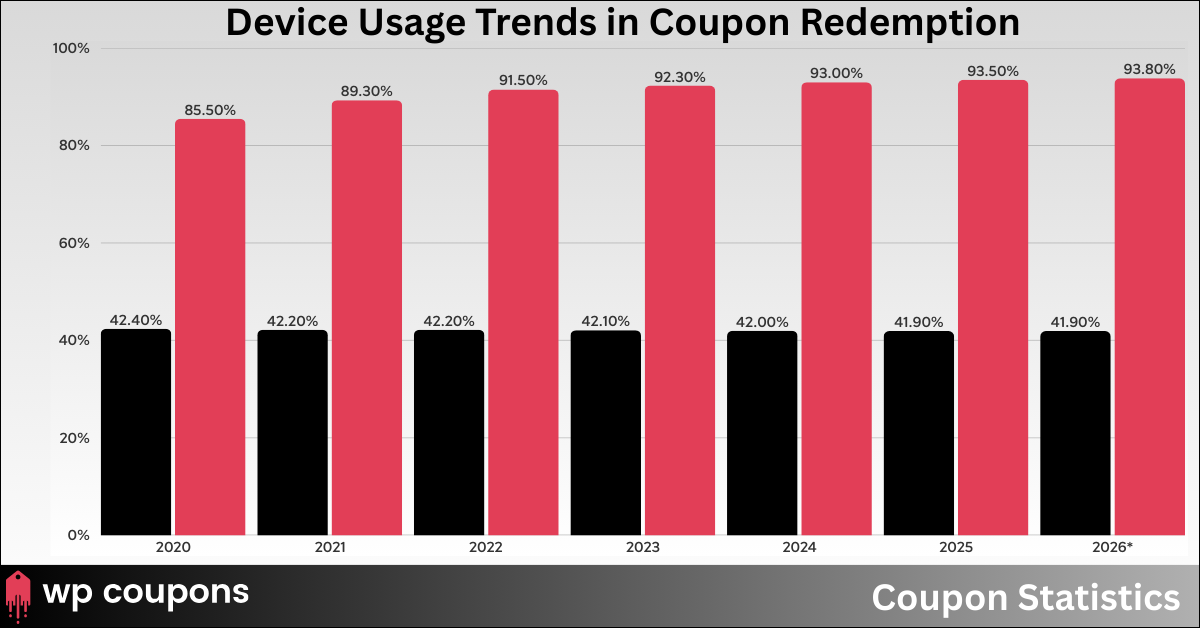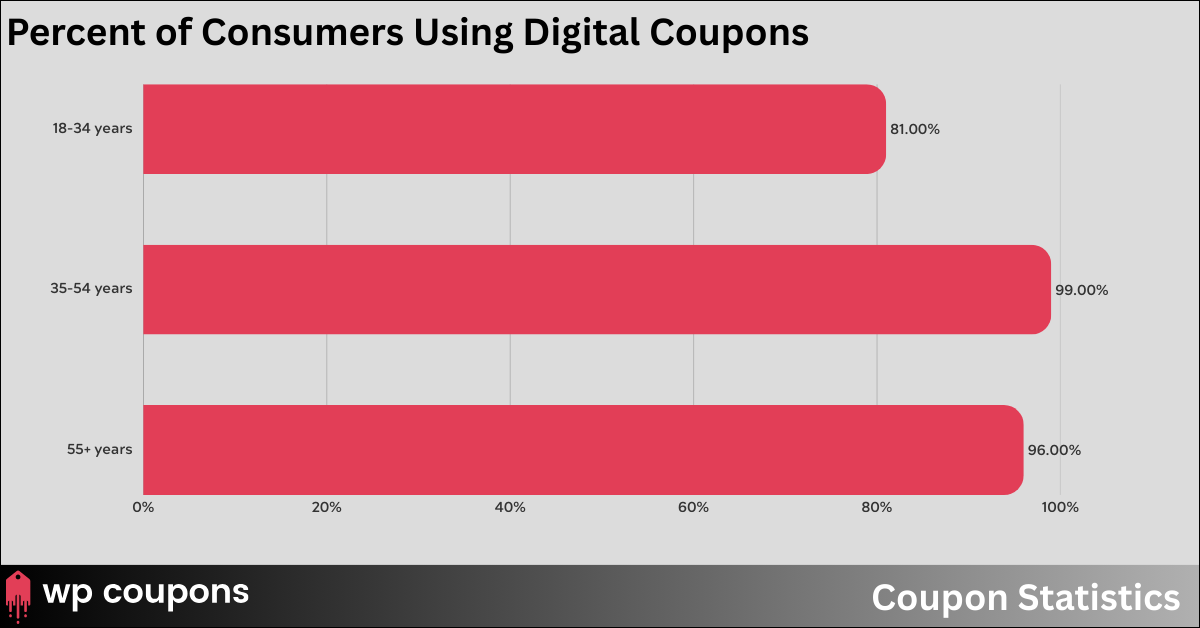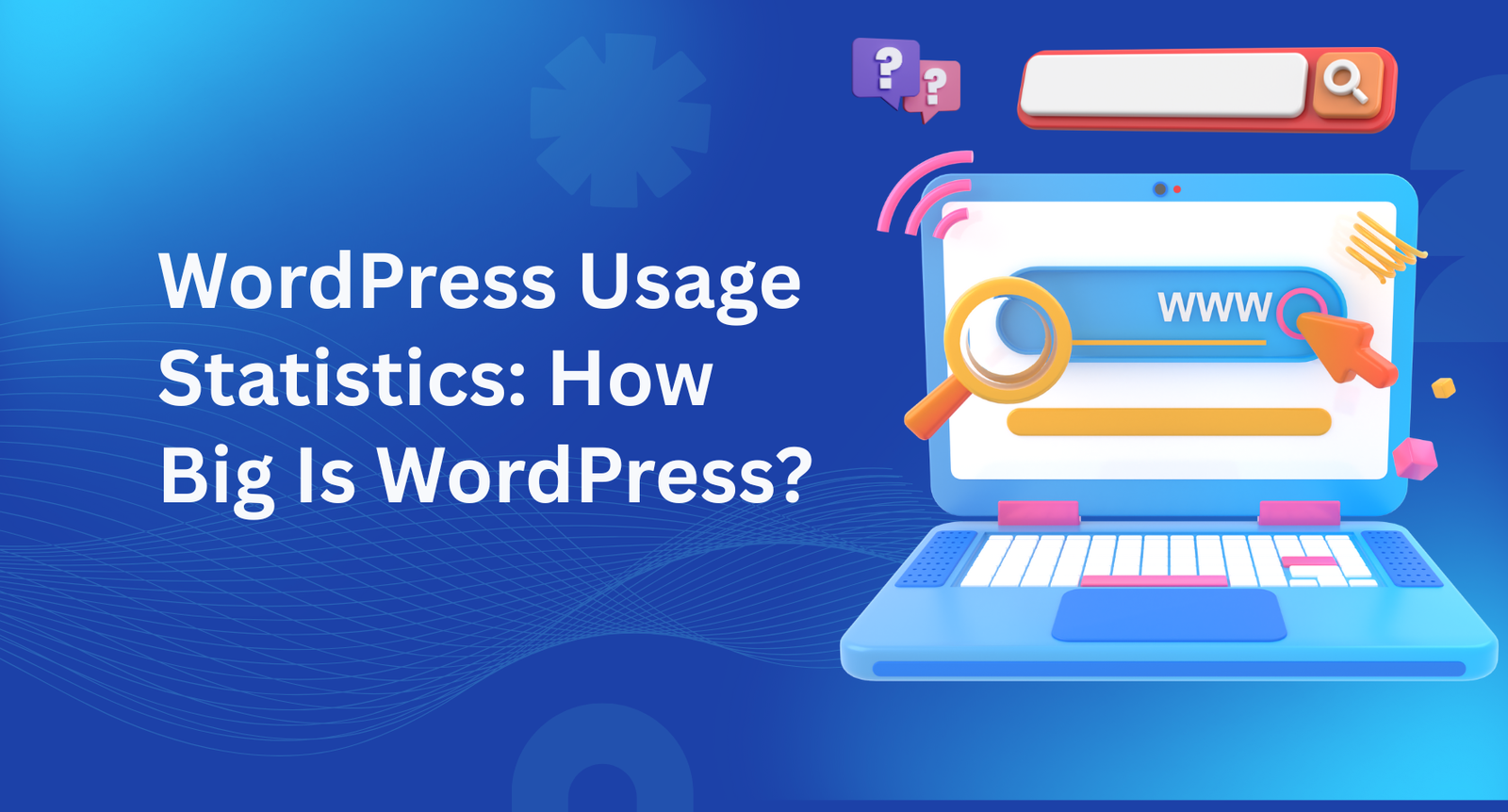Coupons have come a long way from the paper clippings stuffed in Sunday newspapers.
In 2025, they are smarter, digital, and more influential than ever. They are shaping how people shop, save, and discover new products.
The global digital coupon market is now worth $10.57 billion, growing with a rapid CAGR of 19.16%, and it’s only gaining momentum.
Thus, the coupons are a powerful tool for both consumers and brands. In this article, I have listed the latest coupon statistics for 2025. I have also covered everything from market share and user behavior to redemption trends and insights.
So let’s quickly get into the details!
Table of Contents
- Coupon Statistics 2025: Top Picks
- Global Coupon Market Size and Growth
- How Many People use Coupons?
- Coupon Redemption Rates
- Consumer Demographics and Behavior
- How Do Consumers Find Coupons?
- Top Coupon Websites in the Market
- How Much Consumers Save with Coupons?
- Impact of Coupon on Consumer Shopping Behavior
- Top Companies in the Coupon Industry
- Key Challenges in Digital Coupons
- Final Thoughts
- FAQs
Coupon Statistics 2025: Top Picks
- The global coupon market is approximately $10.57 billion as of 2025.
- The coupon market is projected to reach $42.91 billion, with a CAGR of 19.16% by 2033.
- 90% of customers rely on coupons when shopping.
- On average, 7% of digital coupons are redeemed while shopping.
- Over 6 in 10 Americans use promo codes and deals during online purchases.
- 34% of consumers spend 5–10 minutes searching for coupons online.
- The digital coupon industry is expected to grow to $8.96 billion.
- Rakuten is the top global coupon site with 12.39% of visits.
Global Coupon Market Size and Growth
The global coupon market is projected to cross $10.57 billion in 2025. This is an approximate 19% increase from the previous year, which was $8.87 billion in 2024.
And to put more insight, the coupon market size is expected to reach $42.91 billion by the year 2033.
This suggests the compound annual growth rate (CAGR) of 19.16% from 2024 to 2033.

So if this growth continues with a CAGR of over 19.16%, here is the estimated coupon market size over the years:
| Year | Market Size |
| 2023 | $7.57 billion |
| 2024 | $8.87 billion |
| 2025* | $10.57 billion |
| 2026* | $12.59 billion |
| 2027* | $15.01 billion |
| 2028* | $17.89 billion |
| 2029* | $21.32 billion |
| 2030* | $25.39 billion |
| 2031* | $30.22 billion |
| 2032* | $35.95 billion |
| 2033* | $42.91 billion |
(Source: Global Growth Insights)
Market Segmentation by Region
North America leads the global coupon market with over 34% of market share. This region dominates both adoption and revenue generation.
Europe contributes 27% to the global coupon market share, while the Asia-Pacific region holds 29% of the global coupon market share.
The Middle East and Africa claim 10% of the global coupon market.
Here is the global coupon market share by region:
| Region | % of market share |
| North America | 34% |
| Europe | 27% |
| Asia-Pacific | 29% |
| Middle East and Africa | 10% |
North America
- North America’s coupon market share is mainly driven by mobile adoptions, tech-savvy consumers, and e-commerce.
- Over 74% of US consumers regularly use coupons on their purchases, with more than 62% of those using app-based redemptions.
- On the other hand, 58% retailers in the US have integrated coupon systems to offer exclusive coupons.
Europe
- With a 27% global coupon market share, the European market is expanding due to widespread mobile usage.
- More than 66% of consumers in Europe use digital coupons during their purchases, with France, Germany, and the UK being the top adopters.
- More than 51% of the retailers use QR-based discount systems to attract new consumers.
Asia Pacific
- E-commerce, digital payments, and urbanization boost the coupon market share in the Asia Pacific region.
- Over 71% of the buyers from the Asia Pacific region use coupons during their online shopping. Additionally, 63% of consumers use e-coupons and scannable codes.
Middle East and Africa
- Over 48% of the online buyers in the Middle East and Africa use coupons when shopping.
(Source: Global Growth Insights)
How Many People use Coupons?
As of today, over 90% of consumers have used coupons while shopping.
This means 9 out of 10 consumers love to save during their shopping using coupon discounts.
62% of U.S consumers actively search for and use coupons, promo codes, and discounts during their online shopping.
(Source: Statista, Global Growth Insights)
Digital Coupon Usage Statistics
Digital coupons now account for 33.3% of all coupon redemptions, while traditional free-standing inserts represent 24.2%, and instant redeemable coupons make up just 15.3%.
- 85% of the global consumers use digital coupons during the purchase, while 70% of consumers actively search for coupons and discounts through their smartphones.
- 57% of shoppers prefer digital coupons over paper ones.
- Digital coupons have redemption rates up to 10 times higher than paper coupons.
- 68% of shoppers find digital coupons more convenient than paper coupons.
- In 2025, 33% of grocery shoppers in the United States increased their coupon usage, up from approximately 26% in 2023.
Below are insights on the frequency of coupon usage by online buyers in the US:
| Frequency of online coupon usage | Percentage of online buyers |
| Occasionally | 51% |
| Almost every time | 22% |
| Always | 14% |
| For half of the purchases | 13% |
(Source: Statista)
Coupon Redemption Rates
Digital coupons are the most widely used, representing one-third of all coupon redemptions, while instant redeemable coupons make up just 15%.
In 2023, the coupon redemption rate increased by 10.4% from 2022, marking the first rise since 2008.
As of 2025, digital coupons have an average redemption rate of around 7% and higher.
Take a look at the average redemption rate by type of coupons:
| Coupon Type | Redemption Rate |
| Digital Coupons | 33.3% |
| Free-standing insert | 24.22% |
| Instant Redeemable coupons | 15.3% |
| Other | 27.2% |
Device Usage for Redemption by Consumers
The dominance of mobile devices in coupon redemption continues to grow. Currently, 93% of digital coupon users access and redeem coupons via smartphones.
Mobile phones were responsible for the redemption of nearly 80% of all coupons in 2022.

Here are the redemption stats by device type over the years:
| Year | Tablet Users (%) | Smartphone Users (%) |
| 2020 | 42.4% | 85.5% |
| 2021 | 42.2% | 89.3% |
| 2022 | 42.2% | 91.5% |
| 2023 | 42.1% | 92.3% |
| 2024 | 42.0% | 93.0% |
| 2025 | 41.9% | 93.5% |
| 2026* | 41.9% | 93.8% |
(Source: Statista, Global Growth Insights)
Consumer Demographics and Behavior

Millennials are the most coupon-responsive generation, with 89% of them trying a new brand if offered a discount.
The generational breakdown for brand switching due to coupons shows:
| Generation | Percent of consumers switching to the brand that offers coupons |
| Millennials | 89% |
| Gen X | 86% |
| Gen Z | 78% |
| Baby Boomers | 76% |
Interestingly, 85.5% of Gen Z shoppers wait for coupon code offers before making purchases.
81% of the consumers aged between 18 and 34 use digital coupons as they like online and easy shopping.

Here are the overall digital coupon usage by age groups:
| Age | Percent of consumers using digital coupons |
| 18-34 years | 81% |
| 35-54 years | 99% |
| 55+ years | 96% |
To be more precise, 70% of Millennials use digital coupons more frequently than paper ones, while Gen Z follows closely with 62%.
Here are the generational preferences of the coupon type:
| Generation | Digital Coupons | Paper Coupons |
| Gen Z | 62% | 38% |
| Millennials | 70% | 30% |
| Generation X | 61% | 39% |
| Baby Boomers | 44% | 56% |
| Silent Generation | 11% | 89% |
Socio-economic factors of Consumers using coupons
29% of college graduates use digital coupons to save money.
This behavior extends across educational levels, with 24% of individuals with some college education and 20% of high school graduates also using digital coupons.
Among employment groups, 27% of full-time workers report using coupons. However, this usage is lower among retirees, with only 18% engaging in digital coupon use.
Take a look at the digital coupons used by different consumer groups:
| Consumer groups | Percent of consumers using digital coupons |
| College graduates | 29% |
| Individuals with a college education | 24% |
| High School graduates | 20% |
| Full-time workers | 27% |
| Unemployed people | 22% |
| Students | 25% |
| Retired consumers | 18% |
(Source: Snipp)
Time Spent Searching for Coupon Codes
Typically, 34% of consumers take around 5 to 10 minutes searching for coupons online.
Interestingly, around 2% of shoppers dedicate over an hour to finding the perfect deal.
Let’s take a look at the time spent by consumers looking for online coupons:
| Time taken to search for a coupon | Percentage of consumers |
| 1 to 5 minutes | 26% |
| 5 to 10 minutes | 34% |
| 10 to 20 minutes | 20% |
| 20 to 30 minutes | 12% |
| 30 to 40 minutes | 4% |
| 40 to 50 minutes | 2% |
| More than 60 minutes | 2% |
Success Rate of Digital Coupons Found Online
50% of users found that digital coupons sourced online were valid just 10–50% of the time. Conversely, only 9% reported a high success rate of 90%.
While half of the shoppers indicated limited success with online digital coupons (validity of 10–50%), only 9% reported a high reliability rate of 90%.
| The success rate of the digital coupon found | Percentage of online buyers |
| Over 90% of the time | 9% |
| 70-90% of the time | 10% |
| 50-70% of the time | 17% |
| 30-50% of the time | 24% |
| 10-30% of the time | 26% |
| Less than 10% of the time | 14% |
(Source: Statista)
Consumer Preference for Coupon Types
“Percentage off” deals are the most popular, with 67% of consumers favoring this format.
Besides that, “Buy One, Get One Free (BOGO)” offers are preferred by 61% of shoppers, and free shipping coupons, which appeal to 57% of consumers.
Let’s take a look at the most preferred coupon types by consumers:
| Type of coupon | Chosen by the percentage of consumers |
| Percentage off | 67% |
| Buy one, get one free | 61% |
| Free shipping | 57% |
| Fixed amount off | 48% |
| Other | 1% |
How Do Consumers Find Coupons?
Today’s consumers are increasingly turning to digital tools to uncover savings while they shop.
Smartphones play a central role, with around 40% of shoppers using their devices to search for discounts and coupons during their shopping experience.
This behavior is particularly strong in physical retail environments, where 35% of U.S. consumers access or download digital coupons while shopping in-store.
Email marketing also plays a powerful role in discovery, with nearly half of consumers finding coupons through promotional emails.
When it comes to active deal hunting, 45% go directly online to find savings, while about one-third rely on dedicated coupon websites.
Take a look at the insights below on how consumers search and find coupons:
| Coupon source | Percentage of consumers |
| Personal emails from brands | 47% |
| Online searches | 46% |
| Coupon websites | 34% |
| Coupon from previous purchases | 33% |
| Deal aggregators | 28% |
| Mail catalogues or flyers | 22% |
| Social Media posts from brands | 21% |
| Browser Extensions | 21% |
| Paid social media ads | 16% |
| Influencers on social media | 13% |
| Through podcasts or sponsorships | 7% |
(Source: Coupon Follow, Statista)
Did you know? Out of over 1.1 billion websites worldwide, 43% are powered by WordPress.
As consumers increasingly turn to digital platforms to find savings, social media has become a powerful channel for discovering promo codes and discounts.
Topping the list by a wide margin, 42% of U.S. shoppers rely on Facebook to find coupons and promo codes.
Following Facebook, Instagram is the second most-used platform, with 30% of shoppers using it to uncover discounts.
Here are some insights on social media platforms where consumers look for coupons:
| Social media platforms | The percentage of consumers using it to find the coupons |
| 42% | |
| 30% | |
| YouTube | 25% |
| Facebook Groups | 18% |
| 14% | |
| 13% | |
| TikTok | 12% |
| 12% | |
| Snapchat | 8% |
| 6% |
(Source: Statista)
Top Coupon Websites in the Market
Globally, Rakuten stands out as the most visited coupon website, commanding 12.39% of global visits.
Slickdeals.net follows closely, attracting 9.57% of global coupon site traffic. Known for its active user community and curated deal forums, Slickdeals offers shoppers real-time updates on trending savings.
Capital One Shopping (formerly Wikibuy) ranks third globally with 8.22% of the total share.
Here are the most popular global coupon websites that consumers follow to find the coupons:
| Coupon websites | Percent share of visits |
| rakuten.com | 12.39% |
| slickdeals.net | 9.57% |
| capitaloneshopping.com | 8.22% |
| linksprf.com | 2.61% |
| joinhoney.com | 2.54% |
Consumer loyalty and usage habits also reveal which platforms are most trusted. In 2023, Honey emerged as the most popular coupon aggregator among U.S. consumers, with 29% reporting regular use.
Close behind, RetailMeNot earned a loyal following with 28%, while Rakuten and Coupons.com were tied at 21%. Swagbucks, with its mix of coupons and rewards, attracted 20% of regular users.
Take a look at the following coupon aggregators that are leading:
| Coupon Aggregators | Percentage Of Consumers Regularly Using |
| Honey | 29% |
| RetailMeNot | 28% |
| Rakuten | 21% |
| Coupons.com | 21% |
| Swagbucks | 20% |
(Source: Statista)
How Much Consumers Save with Coupons?
According to a 2021 study by CouponFollow, the average American household can save up to $1,465 annually just by using digital coupons across everyday purchases.
- Groceries (“Food at Home”) top the list, with households saving an average of $316 per year.
- Household items, such as cleaning supplies and paper products, account for another $272 in annual savings.
- Dining out follows closely, where families cut costs by an average of $264.
Here are the areas where consumers are saving money with coupons:
| Areas where consumers save money with coupons | Total savings with coupons |
| Automotive expenses | $138 |
| Apparel and accessories | $135 |
| Personal care and beauty | $66 |
| Alcohol | $47 |
| Travel | $37 |
| Tobacco & smoking products | $26 |
| Books and reading materials | $5 |
While the potential for savings is high, how much consumers actually save each month varies significantly:
- 35% of consumers report saving between $10 and $25 per month using digital coupons.
- 23% enjoy moderate savings of $25–$50 per month.
- 29% save less than $10 monthly, often due to occasional use or limited spending.
- 9% report saving between $50 and $100 monthly, while only 4% manage to save over $100, indicating that high savings are possible but less common.
| Monthly Savings | Percentage of buyers saving money using coupons |
| Less than $10 | 29% |
| $10– $25 | 35% |
| $25– $50 | 23% |
| $50– $100 | 9% |
| More than $100 | 4% |
Impact of Coupon on Consumer Shopping Behavior
A remarkable 83% of shoppers say that coupons influence their purchase decisions.
For many, the presence of a discount can be the deciding factor between buying and waiting or between choosing a familiar brand versus trying something new.
Coupons don’t just influence “what” people buy, but also “when” and “why.” The data shows:
- 39% of shoppers made a purchase earlier than planned because of a coupon.
- Another 39% tried a new brand they wouldn’t have considered without the added incentive.
- 18% returned to a brand they had previously abandoned, reinforcing the idea that coupons can also build brand loyalty.
- Additionally, 19% of consumers were driven to try entirely new products thanks to a deal or promo code.
- 19% of shoppers said coupons were the reason they discovered a new product.
- Similarly, 13% consider coupon sites a useful resource for learning more about a product less than half the number who turn to search engines (53%) or customer reviews (32%).
| Sources Of Information | Percentage Of Consumers |
| Coupon and deal websites and apps | 13% |
| Price comparison websites | 15% |
| Online forums | 16% |
| Video websites and apps (e.g., YouTube) | 25% |
| Friends and acquaintances | 26% |
| Social media websites and apps | 27% |
| Brand websites and apps | 28% |
| In the store | 31% |
| Customer reviews | 32% |
| Online stores | 33% |
| Search engines (e.g., Google and Bing) | 53% |
(Source: Statista)
Top Companies in the Coupon Industry
Amazon stands as the undisputed leader in e-commerce coupon integration.
Some of the top companies in the coupon market are:
- Amazon
- Kroger
- Groupon
- Rakuten
- Honey
On Amazon, sellers report that approximately 50% of customers use coupons when one is offered.
Kroger customers clipped 4 billion digital coupons in 2023, representing a massive 1 billion increase from 2022.
Key Challenges in Digital Coupons
The two biggest issues in the digital coupon market are data privacy concerns and poor user experience.
| Key Challenge | Stats |
| Consumers worried about data tracking | 62% |
| Users are not willing to share their personal data | 48% |
| Mobile app users are discontinuing the promos and offers | 41% |
| Marketers are facing fragmentation in the platform | 57% |
| Users are not using coupons due to redemption issues | 43% |
| Consumers who get dysfunctional or expired coupons | 39% |
Consumers are growing more cautious about their data, and it is impacting the way digital coupons are used. Here’s what’s happening:
- 62% of consumers are uncomfortable with apps tracking their behavior for targeted coupon offers.
- 48% of users hesitate to share personal data (like shopping history, preferences, and location) to access digital coupons.
- 41% of mobile app users opt out of push notifications, reducing the success of promotional campaigns.
This reluctance means fewer opportunities for marketers to deploy highly personalized promotions.
The poor user interface and fragmentation are also challenges in the coupon market.
The fact is:
- 57% of marketers struggle to manage campaigns across multiple apps and coupon aggregators.
- 43% of users give up on using digital coupons because redemption processes are confusing or incompatible at checkout.
- 39% of consumers have received expired or non-functional coupons, leading to frustration and diminishing trust.
Most people want value, but not if it means giving up too much personal data or wrestling with glitchy systems.
(Source: Global Growth Insights)
Final Thoughts
So, we can see that coupons and offers have become an integral part of our shopping experience.
As AI technology and mobile integration continue to evolve, consumers are experiencing more personalized and secure couponing experiences.
Consumers seem to love couponing and discount offers, as they stand to benefit from them. On average, consumers experience household savings of over $1,400 each year, and the convenience of redeeming coupons within days of receiving them.
Looking ahead, coupons will become even smarter and more integrated into our shopping journeys.
What are your thoughts on this? Let us know in the comments section below.
FAQs
How many people actually use coupons?
Over 90% of consumers have used coupons as of today. In 2020, more than 142 million US consumers redeemed digital coupons and this number has continued to rise each year.
How big is the coupon industry?
As of 2025, the coupon industry is worth $10.57 billion, with a CAGR of 19.16%.
What percentage of coupons are redeemed?
The average redemption rate for digital coupons is about 7%, while the overall coupon redemption rate is roughly 0.77% in the US.
Do coupons really save money?
Yes, people who use coupons save an average of $1,465 per year, and typically spend 24% more per shopping trip compared to those who don’t use coupons.
What is a normal coupon size?
A typical coupon provides a discount ranging from 10% to 30% off, or a set dollar amount such as $5 or $20 off a purchase.



